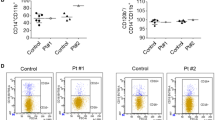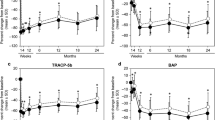Abstract
We have recently reported a long-lasting decrease in circulating γδ T cells in osteoporotic patients on oral amino-bisphosphonates (N-BPs). Here we verify whether these changes are associated with the occurrence of acute phase response (APR) to intravenous (IV) zoledronic acid (ZOL) or changes of other circulating white blood cells (WBC). WBC count was obtained before and 1 year after a single IV administration of 5 mg ZOL in 36 osteoporotic patients (mean age 72 ± 9, range 45–86 years) without other relevant diseases; 12 of 36 patients developed the classical APR. After 1 year in the patients who experienced an APR, but not in the others, a significant decrease not only of γδ T cells (−30 %), but also of total lymphocytes (−11 %) and eosinophils (−27 %), was observed. The mechanism leading to the observed decrease of circulating lymphocytes and eosinophils remains unclear, but our observation opens a new frontier for the understanding of the immunoeffects of N-BPs.

Similar content being viewed by others
References
Adami S, Bhalla AK, Dorizzi R, Montesanti F, Rosini S, Salvagno G, Lo Cascio V (1987) The acute-phase response after bisphoshonate administration. Calcif Tissue Int 41:326–333
Schweitzer DH, Oostendorp-van de Ruit M, Van der Pluijm G, Lowik CW, Papapoulos SE (1995) Interleukin-6 and the acute phase response during treatment of patients with Paget’s disease with the nitrogen-containing bisphosphonate dimethyl-amino-hydroxy-propylidene bisphosphonate. J Bone Miner Res 10:956–962
Kunzmann V, Bauer E, Wilhelm M (1999) Gamma/delta T-cell stimulation by pamidronate. N Engl J Med 340:737–738
Roelofs AJ, Jauhiainen M, Monkkonen H, Rogers MJ, Monkkonen J, Thompson K (2009) Peripheral blood monocytes are responsible for gamma delta T cell activation induced by zoledronic acid through accumulation of IPP/DMAPP. Br J Haematol 144:245–250
Miyagawa F, Tanaka Y, Yamashita S, Minato N (2001) Essential requirement of antigen presentation by monocyte lineage cells for the activation of primary human gamma delta T cells by aminobisphosphonate antigen. J Immunol 166:5508–5514
Rossini M, Adami S, Viapiana O, Ortolani R, Vella A, Fracassi E, Gatti D (2012) Circulating γδ T cells and the risk of acute-phase response after zoledronic acid administration. J Bone Miner Res 27:227–230
Welton JL, Morgan MP, Martí S, Stone MD, Moser B, Sewell AK, Turton J, Eberl M (2013) Monocytes and γδ T cells control the acute phase response to intravenous zoledronate: insights from a phase IV safety trial. J Bone Miner Res 28:464–471
Rossini M, Adami S, Viapiana O, Fracassi E, Ortolani R, Vella A, Zanotti R, Tripi G, Idolazzi L, Gatti D (2012) Long-term effects of amino-bisphosphonates on circulating gammadelta T cells. Calcif Tissue Int 91:395–399
Kalyan S, Quabius ES, Wiltfang J, Mönig H, Kabelitz D (2013) Can peripheral blood γδ T cells predict osteonecrosis of the jaw? An immunological perspective on the adverse drug-effects of aminobisphosphonate therapy. J Bone Miner Res 28:728–735
Hayday AC (2009) Gammadelta T cells and the lymphoid stress–surveillance response. Immunity 31:184–196
Strid J, Roberts SJ, Filler RB, Lewis JM, Kwong BY, Schpero W, Kaplan DH, Hayday AC, Girardi M (2008) Acute upregulation of an NKG2D ligand promotes rapid reorganization of a local immune compartment with pleiotropic effects on carcinogenesis. Nat Immunol 9:146–154
Tanaka Y, Morita CT, Tanaka Y, Nieves E, Brenner MB, Bloom BR (1995) Natural and synthetic non-peptide antigens recognized by human gamma delta T cells. Nature 375:155–158
Dieli F, Gebbia N, Poccia F, Caccamo N, Montesano C, Fulfaro F, Arcara C, Valerio MR, Meraviglia S, Di Sano C, Sireci G, Salerno A (2003) Induction of γδ T-lymphocyte effector functions by bisphosphonate zoledronic acid in cancer patients in vivo. Blood 102:2310–2311
Lymperi S, Ersek A, Ferraro F, Dazzi F, Horwood NJ (2011) Inhibition of osteoclast function reduces hematopoietic stem cell numbers in vivo. Blood 117:1540–1549
Van den Wyngaert T, Wouters K, Huizing MT, Vermorken JB (2011) RANK ligand inhibition in bone metastatic cancer and risk of osteonecrosis of the jaw (ONJ): non bis in idem? Support Care Cancer 19:2035–2040
Humbles AA, Lloyd CM, McMillan SJ, Friend DS, Xanthou G, McKenna EE, Ghiran S, Gerard NP, Yu C, Orkin SH, Gerard C (2004) A critical role for eosinophils in allergic airways remodeling. Science 305:1776–1779
Cheung PF, Wong CK, Lam CW (2008) Molecular mechanisms of cytokine and chemokine release from eosinophils activated by IL-17A, IL-17F, and IL-23: implication for Th17 lymphocytes-mediated allergic inflammation. J Immunol 180:5625–5635
Kamiya N, Suzuki H, Endo T, Takano M, Yano M, Naoi M, Nishimi D, Kawamura K, Imamoto T, Ichikawa T (2011) Additive effect of zoledronic acid on serum prostate-specific antigen changes for hormone-sensitive prostate cancer patients with bone metastasis treated by combined androgen blockade. Int J Urol 19:169–173
Rennert G, Pinchev M, Rennert HS, Gruber SB (2011) Use of bisphosphonate and reduced risk of colorectal cancer. J Clin Oncol 29:1146–1150
Colón-Emeric CS, Mesenbrink P, Lyles KW, Pieper CF, Boonen S, Delmas P, Eriksen EF, Magaziner J (2010) Potential mediators of the mortality reduction with zoledronic acid after hip fracture. J Bone Miner Res 25:91–97
Disclosure
None.
Author information
Authors and Affiliations
Corresponding author
Additional information
The authors have stated that they have no conflict of interest.
Rights and permissions
About this article
Cite this article
Rossini, M., Adami, S., Viapiana, O. et al. Acute Phase Response After Zoledronic Acid is Associated with Long-Term Effects on White Blood Cells. Calcif Tissue Int 93, 249–252 (2013). https://doi.org/10.1007/s00223-013-9750-6
Received:
Accepted:
Published:
Issue Date:
DOI: https://doi.org/10.1007/s00223-013-9750-6




